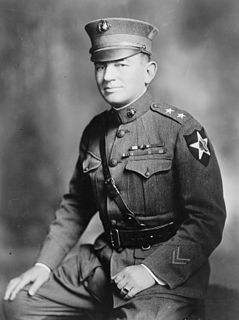
John Archer Lejeune was a United States Marine Corps lieutenant general and the 13th Commandant of the Marine Corps. Lejeune served for nearly 40 years in the military, and commanded the U.S. Army's 2nd Division during World War I. After his retirement from the Marine Corps he became superintendent of the Virginia Military Institute.

The Continental Marines were the amphibious infantry of the American Colonies during the American Revolutionary War. The Corps was formed by the Continental Congress on November 10, 1775 and was disbanded in 1783. Their mission was multi-purpose, but their most important duty was to serve as onboard security forces, protecting the captain of a ship and his officers. During naval engagements Marine sharpshooters were stationed in the fighting tops of the ships' masts, they would also man the cannons along with the crew of the ship and were supposed to shoot the opponent's officers, naval gunners and helmsmen.
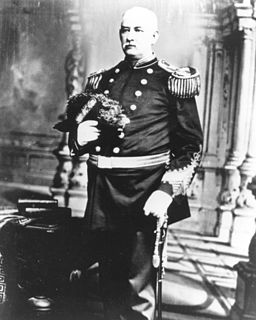
Charles Grymes McCawley was the eighth commandant of the Marine Corps and served as an officer in the United States Marine Corps during the Mexican–American War and the American Civil War.

The 5th Marine Regiment is an infantry regiment of the United States Marine Corps based at Marine Corps Base Camp Pendleton, California. It is the most highly decorated regiment in the Marine Corps and falls under the command of the 1st Marine Division and the I Marine Expeditionary Force.

Marine Aircraft Group 39 (MAG-39) is a United States Marine Corps aviation unit based at Marine Corps Base Camp Pendleton, California that is currently composed of four AH-1Z "Viper" Cobra and UH-1Y "Venom" Huey light attack squadrons, two MV-22 Osprey squadrons, an aviation logistics squadron, a Headquarters Squadron, a Marine Wing Support Squadron and the H-1 Fleet Replacement Squadron. The group falls under the command of the 3rd Marine Aircraft Wing and the 1st Marine Expeditionary Force.

The Eagle, Globe, and Anchor is the official emblem and insignia of the United States Marine Corps. The current emblem traces its roots in the designs and ornaments of the early Continental Marines as well as the United Kingdom's Royal Marines. The present emblem, adopted in 1955, differs from the emblem of 1868 only by a change in the eagle. Before that time many devices, ornaments, ribbons, and distinguishing marks followed one another as official badges of the corps.

The 3rd Reconnaissance Battalion conducts amphibious and ground reconnaissance in support of the 3rd Marine Division and Marine Forces Pacific (MarForPac), operating in the commander's areas of influence. The Battalion is based out of Camp Schwab, a satellite base of Marine Corps Base Camp Smedley D. Butler. It is geographically located on the Okinawa Prefecture in Japan.
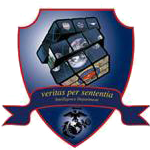
Marine Corps Intelligence is an element of the United States Intelligence Community. The Director of Intelligence supervises the Intelligence Department of HQMC and is responsible for policy, plans, programming, budgets, and staff supervision of Intelligence and supporting activities within the U.S. Marine Corps as well as supervising the Marine Corps Intelligence Activity (MCIA). The Department supports the Commandant of the Marine Corps (CMC) in his role as a member of the Joint Chiefs of Staff (JCS), represents the service in Joint and Intelligence Community matters, and exercises supervision over the MCIA.
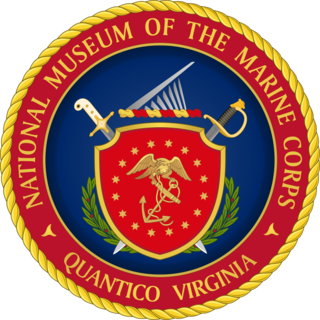
The National Museum of the Marine Corps is the historical museum of the United States Marine Corps. Located in Triangle, Virginia near MCB Quantico, the museum opened on November 10, 2006, and is now one of the top tourist attractions in the state, drawing over 500,000 people annually.
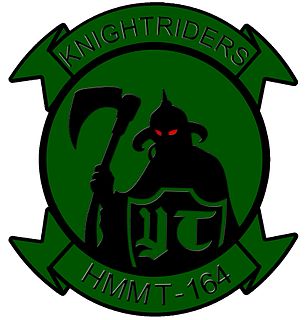
Marine Medium Tiltrotor Squadron 164 (VMM-164), is a United States Marine Corps tiltrotor squadron operating the MV-22B Osprey. Known as the Knightriders, they fall under the command Marine Aircraft Group 39 (MAG-39) and the 3rd Marine Aircraft Wing. They are based at Marine Corps Air Station Camp Pendleton.

Lowell Edward English was a highly decorated officer in the United States Marine Corps with the rank of major general who served in World War II, Korea and Vietnam. He is most noted for his service as assistant division commander, 3rd Marine Division during Vietnam War and later as commanding general, Task Force Delta. He completed his career as commanding general, Marine Corps Recruit Depot San Diego in 1969.

Edwin Howard Simmons was a United States Marine Corps brigadier general. He was a career officer who served in combat during three wars — including landing at Inchon and fighting at the Chosin Reservoir in the Korean War. He was renowned as the official Marine Corps historian, being called "the collective memory of the Marine Corps". His 1974 book The United States Marines: A History is a seminal reference text.
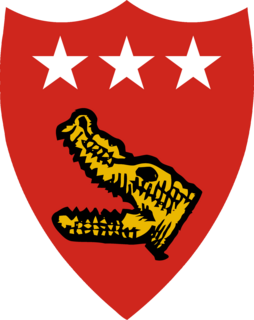
The V Amphibious Corps (VAC) was a formation of the United States Marine Corps which was composed of the 3rd, 4th and 5th Marine Divisions in World War II. The three divisions were the amphibious landing force for the United States Fifth Fleet with two goals, removal of Japanese forces from islands so U.S. Seabees could build advance bases to project US power. In doing this VAC was notably involved in the battles for Tarawa, Saipan, and Iwo Jima. V Amphibious Corps was commanded by General Holland 'Howlin Mad' Smith followed by General Harry Schmidt.

Charles H. Waterhouse was an American painter, illustrator and sculptor renowned for using United States Marine Corps historical themes as the motif for his works. His art spans subjects from Tun Tavern, the birthplace of the U. S. Marines to present day topics. Throughout his career, he created over 500 pieces for the Marine Corps art collection.

The WWII/Korea LVT Museum is located in a Quonset hut-style building at Camp Del Mar, Marine Corps Base Camp Pendleton, California, near the Assault Amphibian School Battalion Training Command. It houses exhibits on landing vehicles tracked (LVTs) from World War II and the Korean War, including six vintage models used by the US Marine Corps. The museum highlights the service of the "Alligator" Marines during the amphibious assaults of World War II and the Korean War. In 1996, the museum won the prestigious Colonel John H. Magruder III Award from the Marine Corps Heritage Foundation.
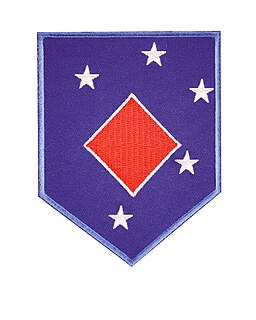
The I Marine Amphibious Corps, or I MAC, was a formation of the United States Marine Corps. It was created on 1 October 1942, with most of the staff transferred from Amphibious Corps, Pacific Fleet (ACPF). It was then deployed to the South Pacific Area – a U.S.-led multinational military command active during World War II that was a part of the U.S. Pacific Ocean Areas – first to Hawaii, then to New Caledonia.

The United States Marine Corps History Division is a branch of Headquarters Marine Corps tasked with researching, writing, and maintaining the History of the United States Marine Corps. It also provides reference and research assistance; preserves personal experiences and observations through oral history interviews; and deploys field historians to record history in the making. It is headquartered at Marine Corps Base Quantico in Virginia.
Operation Virginia Ridge was a US Marine Corps operation that took place in northwest Quảng Trị Province, South Vietnam, from 2 May to 16 July 1969.

Kenneth Wachter Benner was a decorated officer in the United States Marine Corps with the rank of Brigadier general. A graduate of the United States Naval Academy, he trained as Anti-Aircraft Artillery officer and participated in the Defense of Pearl Harbor, Guadalcanal Campaign and Battle of Okinawa.


















